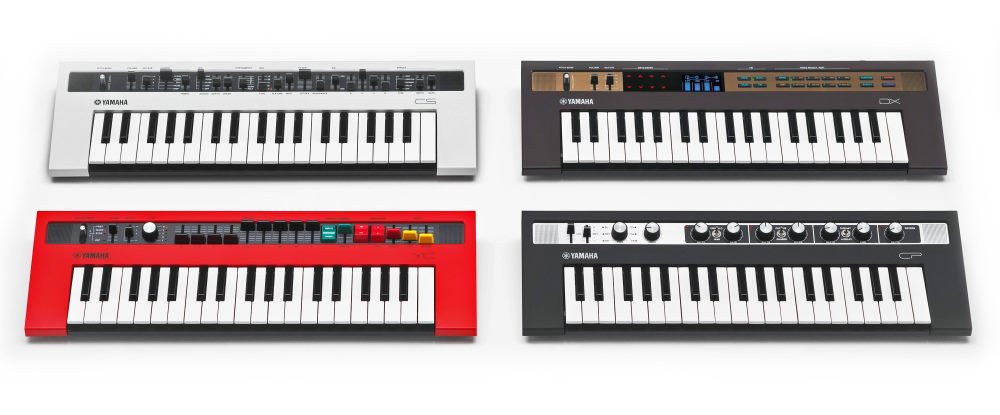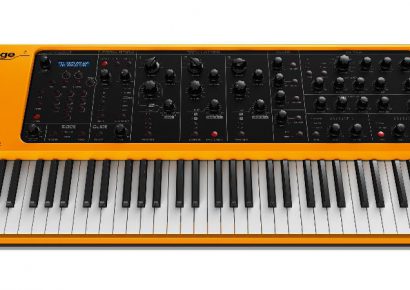DX
The original DX series synths from the ‘80s were revolutionary. Additive synthesis or FM synthesis as it’s more commonly known gave musicians a whole new palette of sounds, previously unheard. So what have Yamaha given us in 2015? Well, the Reface DX is indeed a reimagined FM synth, something not seen in dedicated hardware form for some time. Under the hood is 4 sine wave operators, each with feedback modulation, 12 algorithms (essentially how the 4 sine wave operators are routed), an LFO, 2 fx blocks with the usual suspects, a looper, 4 amp envelopes for each operator and a pitch envelope that can be turned on or off for each operator.
On FM synths in the past the sound design aspect was incredibly difficult to understand and use. But thanks to Reface DX’s large screen, users can now see exactly what’s happening while modifying 4 parameters via a touch screen interface. In fact, the interface is incredibly easy and intuitive. Within 30 seconds of plugging the DX in (after the initial shock of how incredibly small it is), I was modifying parameters, looping bizarro pads, clangs, bells, whistles, and then pulling it back in for disgusting distorted bass. The touch data entry section is something I haven’t seen on a synth before, it almost behaves like a smart phone or tablet’s multi-touch screen.
Dragging four fingers across the arrows to push the feedback up on all four operators is instant fun. Whether or not Yamaha might have been better off including physical sliders with more tactile control is up for debate, however, they’re certainly usable, and match the overall ‘80s throwback aesthetic. A solo electronic musician could easily have this plugged into his/ her laptop on stage running MIDI sequencers and tweaking them live, or even live improvisation/song construction with the excellent looper. Of course, the famous DX series sounds from just about every pop song of the late ‘80s are there too, so if that’s your bag, the Reface DX is your ticket.
CS
Yamaha’s CS series subtractive synths have a long history, and with the resurgence of analogue synthesisers over the last 5 years, it’s no surprise Yamaha have revived the CS name once again. The Reface CS is virtual analogue, a digital emulation of true analogue. However, being equipped with knobs or sliders for every single parameter is truly a revelation in a package this small. Surprisingly, Yamaha have opted to do away with preset memory on the CS. This may be a deal breaker for some, but I love that it forces you to actually learn and understand the underlying concepts of subtractive synthesis, rather than just changing parameters willy nilly. Oscillator selection sits in the middle of the synth, with filter, envelope and fx controls on the right, portamento,
LFO, looper, transpose, volume and pitch bend on the left. The oscillator select has five different options, each of which seem to change the roles of the ‘texture’ and ‘mod’ sliders next to it. For example, on the dual square wave oscillator setting, texture de-tunes an oscillator, all the way up to an octave up, and the mod slider becomes a band-pass filter. On the whole, it’s a good sounding analogue emulation, the lopass filter is resonant, nice and gritty with plenty of character and I couldn’t hear any stepping – a common fault in analogue emulations. The delay fx seems to be an analogue emulation too, tweaking it in the middle of playing some monstrous cinematic pads gives you that delicious sounding off pitch warble that always puts a smile on my face. This synth has some limitations, the envelope selection slider between filter and amp is a begrudgingly elegant solution to having such limited real estate, but in the end, a hardware synth needs character and tactile control to compete with software synth plug-ins and this little guy has it in bucket loads.
CP
The Reface CP builds on Yamaha’s legacy in electric pianos. The original CP series came into existence in the mid ‘70s, in response to demand from musicians for an easily amplifiable stage piano. In the Reface CP, Yamaha have obviously included the classic CP tone, but most exciting to me is the inclusion of classic and highly sought after Wurlitzer, Rhodes and Clavinet sounds. Combined with the inbuilt effects and expressive keyboard, this is a truly incredible sounding package. The retro aesthetic is palpable on the CP, a rubbery black finish, brushed aluminium fascia, switch and dials straight from the ‘60s…it looks really damn nice. We have 6 key tones to work with, a gorgeous sounding drive, a tremelo or velocity sensitive wah, a chorus or phaser, a digital delay or analogue delay and a reverb. Each effect with a basic depth and time/speed/rate control, except for reverb and drive with only depth. More control might be desirable, however, the Yamaha engineers have absolutely nailed it with what we’re given. Full disclosure, I’m not a fantastic keys player, but even I found myself pretending I’m Stevie Wonder on the Clav with the autowah and phaser turned on, then going down to the lowest octave, cranking the reverb and drive for disgusting fuzzy drone. With the popularity of jazzy, soulful beat orientated electronic music, I could see these in many bedroom beat maker’s studios creating those retro organic piano sounds. Hell, with that lush reverb, delay and inclusion of a toy piano tone, you could make an ambient avant-garde album on this thing.
YC
Last but not least, we have the Reface YC, Yamaha’s reimagining of their YC series of combo organs. YC’s appeared on the scene in the late ‘60s.. yes, almost 50 years ago. Staggering isn’t it? In 2015, Yamaha have packed the best organ sounds all into one small, portable package. Maybe for some purists the back breaking weight and size of the originals is worth it, but I’m quite happy to cop the minor sound differences in exchange for reliability and portability. We’ve got 5 different sound engines based on various organs from around the world, including of course Yamaha’s own classic YC sound. There are nine drawbars, a vibrato/chorus rocker switch, rotary speaker emulation, distortion and reverb. Basically everything you need to get whatever organ sound you’re after – whether it’s an aggressive rock’n’roll tone or something more subtle. In my mind these kinds of sounds are more the realm of kick ass traditional keys players, but on an instrument that can be very dependent on playing bass lines and melody lines at the same time… are three octaves of mini keys going to be enough? Potentially not, but in the end, the Reface YC can be used as a MIDI sound module as well as being a portable solution. Any self respecting keys player with magical hands is going to invest in a good quality full size keyboard before exploring portable options – that’s where the YC would come in.
SMALL BUT BIG
The Reface series are tiny… really tiny. But in a marketplace filled with bedroom producers and musicians, available physical space in studios is at an all time premium – I’d be willing to bet a cranky vocal few are vastly outnumbered by musicians excited by Reface’s small stature. There’s plenty of competitors in the market of small synths/ keyboards, but many are plagued by flimsy lightweight feeling hardware. To me the Yamaha’s feel like a step or five up. The build quality is truly excellent. They may look like toys upon first glance but once you start noodling, size is forgotten. With the price in mind, I’d say each of these is a solid deal. Yamaha don’t over promise with the Reface series – you get a high quality product that does what it does very well. Kudos Yamaha, I’ll take one of each please.

